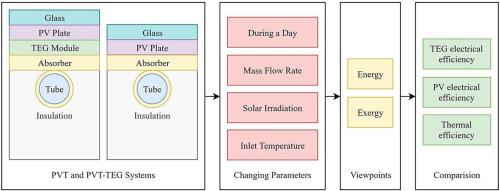当前位置:
X-MOL 学术
›
Energy Convers. Manag.
›
论文详情
Our official English website, www.x-mol.net, welcomes your feedback! (Note: you will need to create a separate account there.)
Semi-3D transient simulation of a nanofluid-base photovoltaic thermal system integrated with a thermoelectric generator
Energy Conversion and Management ( IF 10.4 ) Pub Date : 2020-09-01 , DOI: 10.1016/j.enconman.2020.113073 Arman Kolahan , Seyed Reza Maadi , Arash Kazemian , Corrado Schenone , Tao Ma
Energy Conversion and Management ( IF 10.4 ) Pub Date : 2020-09-01 , DOI: 10.1016/j.enconman.2020.113073 Arman Kolahan , Seyed Reza Maadi , Arash Kazemian , Corrado Schenone , Tao Ma

|
Abstract Thermoelectric generators (TEGs) can produce electricity from the temperature gradients. A combination of TEG with photovoltaic thermal (PVT) systems can be a possible solution for the improvement of their electrical performance. To evaluate the feasibility of using TEG in PVT systems, a comparison between only the PVT system and PVT system integrated with TEG (PVT-TEG) is conducted using numerical simulation. A semi-transient numerical code is developed by FORTRAN software to simulate both PVT and PVT-TEG systems. The governing equations are solved by Tridiagonal Matrix Algorithm (TDMA) using an implicit formulation discretizing by a center-differencing scheme. In this study, aluminum-oxide/water (Al2O3/water) nanofluid is selected as working fluid due to the performance improvement of the systems. Both energy and exergy analysis are conducted to estimate the performance of the nanofluid based PVT-TEG system. The results indicate that the PV unit in both PVT and PVT-TEG systems can generate nearly the same electrical power. However, the PVT-TEG system has 2.5%–4% higher overall electrical energy efficiency compared to only the PVT system. It has been found, in all considered parameters, the PVT-TEG system compared to the PVT system in terms of overall exergy efficiency shows a better performance, while in terms of overall energy efficiency shows poor performance. Furthermore, according to the parametric analysis, there is a direct relation between inlet temperature and photovoltaic (PV) plate temperature, whereas there is an indirect correlation between the inlet temperature and TEG sides difference temperatures.
中文翻译:

与热电发电机集成的基于纳米流体的光伏热系统的半 3D 瞬态模拟
摘要 热电发电机 (TEG) 可以通过温度梯度发电。TEG 与光伏热 (PVT) 系统的组合可以成为改善其电气性能的可能解决方案。为了评估在 PVT 系统中使用 TEG 的可行性,使用数值模拟对仅 PVT 系统和与 TEG 集成的 PVT 系统(PVT-TEG)进行了比较。FORTRAN 软件开发了一种半瞬态数值代码来模拟 PVT 和 PVT-TEG 系统。控制方程通过三对角矩阵算法 (TDMA) 使用由中心差分方案离散化的隐式公式求解。在这项研究中,由于系统的性能改进,选择氧化铝/水(Al2O3/水)纳米流体作为工作流体。进行能量和火用分析以评估基于纳米流体的 PVT-TEG 系统的性能。结果表明 PVT 和 PVT-TEG 系统中的 PV 单元可以产生几乎相同的电力。然而,与仅 PVT 系统相比,PVT-TEG 系统的整体电能效率提高了 2.5%–4%。已经发现,在所有考虑的参数中,PVT-TEG系统与PVT系统相比在整体火用效率方面表现出更好的性能,而在整体能量效率方面表现出较差的性能。此外,根据参数分析,入口温度与光伏 (PV) 板温度之间存在直接关系,而入口温度与 TEG 侧温差之间存在间接相关性。
更新日期:2020-09-01
中文翻译:

与热电发电机集成的基于纳米流体的光伏热系统的半 3D 瞬态模拟
摘要 热电发电机 (TEG) 可以通过温度梯度发电。TEG 与光伏热 (PVT) 系统的组合可以成为改善其电气性能的可能解决方案。为了评估在 PVT 系统中使用 TEG 的可行性,使用数值模拟对仅 PVT 系统和与 TEG 集成的 PVT 系统(PVT-TEG)进行了比较。FORTRAN 软件开发了一种半瞬态数值代码来模拟 PVT 和 PVT-TEG 系统。控制方程通过三对角矩阵算法 (TDMA) 使用由中心差分方案离散化的隐式公式求解。在这项研究中,由于系统的性能改进,选择氧化铝/水(Al2O3/水)纳米流体作为工作流体。进行能量和火用分析以评估基于纳米流体的 PVT-TEG 系统的性能。结果表明 PVT 和 PVT-TEG 系统中的 PV 单元可以产生几乎相同的电力。然而,与仅 PVT 系统相比,PVT-TEG 系统的整体电能效率提高了 2.5%–4%。已经发现,在所有考虑的参数中,PVT-TEG系统与PVT系统相比在整体火用效率方面表现出更好的性能,而在整体能量效率方面表现出较差的性能。此外,根据参数分析,入口温度与光伏 (PV) 板温度之间存在直接关系,而入口温度与 TEG 侧温差之间存在间接相关性。



























 京公网安备 11010802027423号
京公网安备 11010802027423号